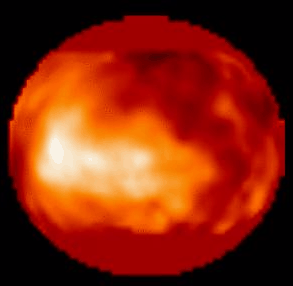Explanation: The surface of Titan, Saturn's largest moon, is normally hidden from view by its thick, hazy atmosphere. However, for the first time astronomers have been able to see surface features in images like the one above, made at near-infrared wavelengths with the Hubble Space Telescope. At these wavelengths (longer than visible light) Titan's smog like atmosphere begins to be transparent enough to allow glimpses of it's surface. The bright feature seen above is about 2,500 miles across, similar in size to Australia. Astronomers are still trying to work out what the bright and dark areas represent - oceans, continents, craters, or other features. The images represent important information for planning the Cassini mission, scheduled for launch in 1997. The Cassini spacecraft will explore the Saturn system and parachute a probe to Titan's surface.
1999 2000 2001 2002 2003 2004 2005 2006 2007 2008 2009 2010 2011 2012 2013 2014 2015 2016 2017 2018 2019 2020 2021 2022 2023 2024 2025 |
Yanvar' Fevral' Mart Aprel' Mai Iyun' Iyul' Avgust Sentyabr' Oktyabr' Noyabr' Dekabr' |
NASA Web Site Statements, Warnings, and Disclaimers
NASA Official: Jay Norris. Specific rights apply.
A service of: LHEA at NASA / GSFC
& Michigan Tech. U.
|
Publikacii s klyuchevymi slovami:
Titan - Titan - atmosfera - infrakrasnoe izluchenie
Publikacii so slovami: Titan - Titan - atmosfera - infrakrasnoe izluchenie | |
Sm. takzhe:
Vse publikacii na tu zhe temu >> | |
